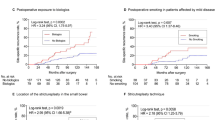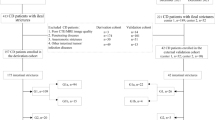Abstract
Background
Small bowel stricture is one of the most common complications in patients with Crohn’s disease (CD). Endoscopic balloon dilatation (EBD) is a minimally invasive treatment intended to avoid surgery; however, whether EBD prevents subsequent surgery remains unclear. We aimed to reveal the factors contributing to surgery in patients with small bowel stricture and the factors associated with subsequent surgery after initial EBD.
Methods
Data were retrospectively collected from surgically untreated CD patients who developed symptomatic small bowel stricture after 2008 when the use of balloon-assisted enteroscopy and maintenance therapy with anti-tumor necrosis factor (TNF) became available.
Results
A total of 305 cases from 32 tertiary referral centers were enrolled. Cumulative surgery-free survival was 74.0% at 1 year, 54.4% at 5 years, and 44.3% at 10 years. The factors associated with avoiding surgery were non-stricturing, non-penetrating disease at onset, mild severity of symptoms, successful EBD, stricture length < 2 cm, and immunomodulator or anti-TNF added after onset of obstructive symptoms. In 95 cases with successful initial EBD, longer EBD interval was associated with lower risk of surgery. Receiver operating characteristic analysis revealed that an EBD interval of ≤ 446 days predicted subsequent surgery, and the proportion of smokers was significantly high in patients who required frequent dilatation.
Conclusions
In CD patients with symptomatic small bowel stricture, addition of immunomodulator or anti-TNF and smoking cessation may improve the outcome of symptomatic small bowel stricture, by avoiding frequent EBD and subsequent surgery after initial EBD.



Similar content being viewed by others
References
Sato Y, Matsui T, Yano Y, et al. Long-term course of Crohn's disease in Japan: Incidence of complications, cumulative rate of initial surgery, and risk factors at diagnosis for initial surgery. J Gastroenterol Hepatol. 2015;30:1713–9.
Van Assche G, Geboes K, Rutgeerts P. Medical therapy for Crohn's disease strictures. Inflamm Bowel Dis. 2004;10:55–60.
Holtmann M, Wanitschke R, Helisch A, et al. Anti-TNF antibodies in the treatment of inflammatory intestinal stenoses in Crohn's disease. Z Gastroenterol. 2003;41:11–7.
Pelletier AL, Kalisazan B, Wienckiewicz J, et al. Infliximab treatment for symptomatic Crohn's disease strictures. Aliment Pharmacol Ther. 2009;29:279–85.
Pallotta N, Barberani F, Hassan NA, et al. Effect of infliximab on small bowel stenoses in patients with Crohn's disease. World J Gastroenterol WJG. 2008;14:1885–900.
Bouguen G, Trouilloud I, Siproudhis L, et al. Long-term outcome of non-fistulizing (ulcers, stricture) perianal Crohn's disease in patients treated with infliximab. Aliment Pharmacol Ther. 2009;30:749–56.
Thienpont C, D'Hoore A, Vermeire S, et al. Long-term outcome of endoscopic dilatation in patients with Crohn's disease is not affected by disease activity or medical therapy. Gut. 2010;59:320–4.
Rodriguez-Lago I, Gisbert JP. The role of immunomodulators and biologics in the medical management of stricturing Crohn’s disease. J Crohns Colitis. 2019. https://doi.org/10.1093/ecco-jcc/jjz1582019.
Bouhnik Y, Carbonnel F, Laharie D, et al. Efficacy of adalimumab in patients with Crohn’s disease and symptomatic small bowel stricture: a multicentre, prospective, observational cohort (CREOLE) study. Gut. 2018;67:53–60.
Yamamoto H, Sekine Y, Sato Y, et al. Total enteroscopy with a nonsurgical steerable double-balloon method. Gastrointest Endosc. 2001;53:216–20.
Tsujikawa T, Saitoh Y, Andoh A, et al. Novel single-balloon enteroscopy for diagnosis and treatment of the small intestine: preliminary experiences. Endoscopy. 2008;40:11–5.
Gionchetti P, Dignass A, Danese S, et al. 3rd European evidence-based consensus on the diagnosis and management of Crohn's DIsease 2016: part 2: surgical management and special situations. J Crohns Colitis. 2017;11:135–49.
Hagel AF, Hahn A, Dauth W, et al. Outcome and complications of endoscopic balloon dilatations in various types of ileocaecal and colonic stenosis in patients with Crohn's disease. Surg Endosc. 2014;28:2966–72.
Atreja A, Aggarwal A, Dwivedi S, et al. Safety and efficacy of endoscopic dilation for primary and anastomotic Crohn's disease strictures. J Crohns Colitis. 2014;8:392–400.
de'Angelis N, Carra MC, Borrelli O, et al. Short- and long-term efficacy of endoscopic balloon dilation in Crohn’s disease strictures. World J Gastroenterol WJG. 2013;19:2660–7.
Hirai F, Andoh A, Ueno F, et al. Efficacy of endoscopic balloon dilation for small bowel strictures in patients with Crohn’s disease: a nationwide, multi-centre, open-label, prospective cohort study. J Crohns Colitis. 2018;12:394–401.
Navaneethan U, Lourdusamy V, Njei B, et al. Endoscopic balloon dilation in the management of strictures in Crohn's disease: a systematic review and meta-analysis of non-randomized trials. Surg Endosc. 2016;30:5434–43.
Morar PS, Faiz O, Warusavitarne J, et al. Systematic review with meta-analysis: endoscopic balloon dilatation for Crohn’s disease strictures. Aliment Pharmacol Ther. 2015;42:1137–48.
Bettenworth D, Gustavsson A, Atreja A, et al. A pooled analysis of efficacy, safety, and long-term outcome of endoscopic balloon dilation therapy for patients with stricturing Crohns disease. Inflamm Bowel Dis. 2017;23:133–42.
Sunada K, Shinozaki S, Nagayama M, et al. Long-term outcomes in patients with small intestinal strictures secondary to Crohn’s disease after double-balloon endoscopy-assisted balloon dilation. Inflamm Bowel Dis. 2016;22:380–6.
Hirai F, Beppu T, Takatsu N, et al. Long-term outcome of endoscopic balloon dilation for small bowel strictures in patients with Crohn’s disease. Dig Endosc. 2014;26:545–51.
Okazaki N, Inokuchi T, Hiraoka S, et al. Findings of retrograde contrast study through double-balloon enteroscopy predict the risk of bowel resections in patients with Crohn's disease with small bowel stenosis. Inflamm Bowel Dis. 2017;23:2097–103.
Satsangi J, Silverberg MS, Vermeire S, et al. The Montreal classification of inflammatory bowel disease: controversies, consensus, and implications. Gut. 2006;55:749–53.
Lian L, Stocchi L, Remzi FH, et al. Comparison of endoscopic dilation vs surgery for anastomotic stricture in patients with Crohn's disease following ileocolonic resection. Clin Gastroenterol Hepatol. 2017;15:1226–311.
Gill RS, Kaffes AJ. Small bowel stricture characterization and outcomes of dilatation by double-balloon enteroscopy: a single-centre experience. Therap Adv Gastroenterol. 2014;7:108–14.
Despott EJ, Gupta A, Burling D, et al. Effective dilation of small-bowel strictures by double-balloon enteroscopy in patients with symptomatic Crohn's disease (with video). Gastrointest Endosc. 2009;70:1030–6.
Nishida Y, Hosomi S, Yamagami H, et al. Analysis of the risk factors of surgery after endoscopic balloon dilation for small intestinal strictures in Crohn's disease using double-balloon endoscopy. Intern Med. 2017;56:2245–52.
Jeuring SF, van den Heuvel TR, Liu LY, et al. Improvements in the long-term outcome of Crohn’s disease over the past two decades and the relation to changes in medical management: results from the population-based IBDSL cohort. Am J Gastroenterol. 2017;112:325–36.
Akobeng AK, Zhang D, Gordon M, et al. Enteral nutrition for maintenance of remission in Crohn’s disease. Cochrane Database Syst Rev. 2018;8:CD005984.
Narula N, Dhillon A, Zhang D, et al. Enteral nutritional therapy for induction of remission in Crohn’s disease. Cochrane Database Syst Rev. 2018;4:CD000542.
Acknowledgements
This study has not received any direct financial support. Although recruitment of investigators to this study was conducted in part at a conference called the AIM Jr meeting, funded by Eisai Co., Ltd. and EA Pharma Co., Ltd., the study design, including development of the protocol, statistical analysis and drafting of the manuscript were performed only by the investigators. Therefore, this study does not have any relationship with Eisai Co., Ltd. and EA Pharma Co., Ltd.
Author information
Authors and Affiliations
Contributions
Conceptualization: SB and RS. Methodology: SB, RS, TF, SS, and TK. Formal analysis: SB and RS. Investigations: all authors. Writing—original draft: SB. Writing—review and editing: SB and RS. Supervision: TF, SS, KM, TS, TK, AA, and TH. Approval of final manuscript: all authors.
Corresponding author
Ethics declarations
Conflict of interest
SB received lecture fees from AbbVie GK, Mitsubishi Tanabe Pharma Co., Ltd., Kyorin Pharmaceutical Co., Ltd., Janssen, Mochida Pharmaceutical, Nippon Kayaku, Zeria Pharmaceutical Co., Ltd., and EA Pharma Co., Ltd., and research support from AbbVie GK, and MSD Inc. RS received lecture fees from Mitsubishi Tanabe Pharma Co., Ltd., Janssen, AbbVie GK, EA Pharma Co., Ltd., and Nippon Kayaku. TF received research support from Eisai Co., Ltd., and Alfresa Co., Ltd., and lecture fees from AbbVie, Ajinomoto Pharma, Boehringer Ingelheim, Daiichi Sankyo Co., Ltd., EA Pharma Co., Ltd., Janssen, Kissei Pharmaceutical, Kyorin Pharmaceutical Co., Ltd., Kyowa Hakko Kirin, Mitsubishi Tanabe Pharma Co., Ltd., Mochida Pharmaceutical, Nippon Kayaku, and Zeria Pharmaceutical Co., Ltd. HS received research support from Bristol-Myers Squibb, AbbVie GK, MSD Inc., Daiichi Sankyo Co., Ltd., and Zeria Pharmaceutical Co., Ltd. SS received lecture fees from Mitsubishi Tanabe Pharma Co., Ltd., AbbVie GK, EA Pharma Co., Ltd., and Nippon Kayaku. HTan received lecture fees from JIMRO Co., Ltd., AbbVie GK, EA Pharma Co., Ltd., Mochida Pharmaceutical Co., Ltd., Kyorin Pharmaceutical Co., Ltd., and Mitsubishi Tanabe Pharma Co., Ltd. RO received lecture fees from AbbVie GK. KKa received lecture fees from Mitsubishi Tanabe Pharma Co., Ltd. and AbbVie GK. YS received lecture fees from Mitsubishi Tanabe Pharma Co., Ltd. and EA Pharma Co., Ltd. KKi received lecture fees from Mitsubishi Tanabe Pharma Co., Ltd., AbbVie GK, EA Pharma Co., Ltd., Janssen, Nippon Kayaku, and Olympus, and research support from AbbVie GK and Zeria Pharmaceutical. SA received lecture fees from Janssen, Mitsubishi Tanabe Pharma Co., Ltd., and JIMRO Co., Ltd. TKo received lecture fees from AbbVie GK, Ajinomoto Pharma, Asahi Kasei Medical, Astellas, Alfresa Pharma, Celltrion, EA Pharma Co., Ltd., Eisai Co., Ltd., Gilead Sciences, Janssen, JIMRO Co., Ltd., Kyorin Pharmaceutical Co., Ltd., Nippon Kayaku, Mochida Pharmaceutical, Takeda Pharmaceutical, Mitsubishi Tanabe Pharma Co., Ltd., and ZERIA Pharmaceutical Co., Ltd., and consulting fees from Alfresa Pharma, Covidien, Eli Lilly, Ferring Pharmaceuticals, Janssen, Kyorin Pharmaceutical Co., Ltd., Mochida Pharmaceutical, Nippon Kayaku, Pfizer, Takeda Pharmaceutical, and Thermo Scientific, and research support from EA Pharma Co., Ltd., Thermo Fisher Scientific, Alfresa Pharma, Nippon Kayaku, and Asahi Kasei Medical. AA received lecture fees from AbbVie GK, Mitsubishi Tanabe Pharma Co., Ltd., Kyorin Pharmaceutical Co., Ltd., Janssen, Astellas, Zeria Pharmaceutical, Miyarisan Pharmaceutical, Takeda Pharmaceutical, Bristol-Myers Squibb, Gilead Sciences, MSD Inc., and EA Pharma Co., Ltd., and research support from EA Pharma Co., Ltd., AbbVie GK, MSD Inc., and Mochida Pharmaceutical, and consulting fees from Mochida Pharmaceutical Co., Ltd., and Takeda Pharmaceutical. TH received lecture fees from Mitsubishi Tanabe Pharma Co., Ltd., Kyorin Pharmaceutical Co., Ltd., AbbVie GK, Janssen, JIMRO Co., Ltd., EA Pharma Co., Ltd., Mochida Pharmaceutical Co., Ltd., Takeda Pharmaceutical, Gilead Sciences, Celltrion, Nippon Kayaku, Kissei Pharmaceutical, Miyarisan Pharmaceutical, Zeria Pharmaceutical Co., Ltd., and Ferring Pharmaceutical, and advisory/consultancy fees from AbbVie GK, Takeda Pharmaceutical, Mitsubishi Tanabe Pharma Co., Ltd., JIMRO Co., Ltd., EA Pharma Co., Ltd., Eli Lilly, Pfizer Japan Inc, Nichi-Iko Pharmaceutical, and Nippon Kayaku, and research support from EA Pharma, AbbVie GK, JIMRO Co., Ltd., Zeria Pharmaceutical Co. Ltd., and Otsuka Pharmaceutical Co., Ltd. However, none of the above is relevant to this article.
Additional information
Publisher's Note
Springer Nature remains neutral with regard to jurisdictional claims in published maps and institutional affiliations.
Electronic supplementary material
Below is the link to the electronic supplementary material.
535_2020_1670_MOESM2_ESM.tif
Supplementary file2 Supplementary Figure 1. Cumulative surgery-free survival for all patients. Kaplan-Meier curves depicting cumulative surgery-free survival for all patients stratified by sex (a), disease location (b), disease behavior (c), perianal lesion (d), smoking (e), location of stricture (f), number of strictures (g). P values on each curve were calculated using the log-rank test. L1: ileal; L3: ileocolonic; B1: non-stricturing, non-penetrating; B2: stricturing (TIF 1090 kb)
Rights and permissions
About this article
Cite this article
Bamba, S., Sakemi, R., Fujii, T. et al. A nationwide, multi-center, retrospective study of symptomatic small bowel stricture in patients with Crohn’s disease. J Gastroenterol 55, 615–626 (2020). https://doi.org/10.1007/s00535-020-01670-2
Received:
Accepted:
Published:
Issue Date:
DOI: https://doi.org/10.1007/s00535-020-01670-2




